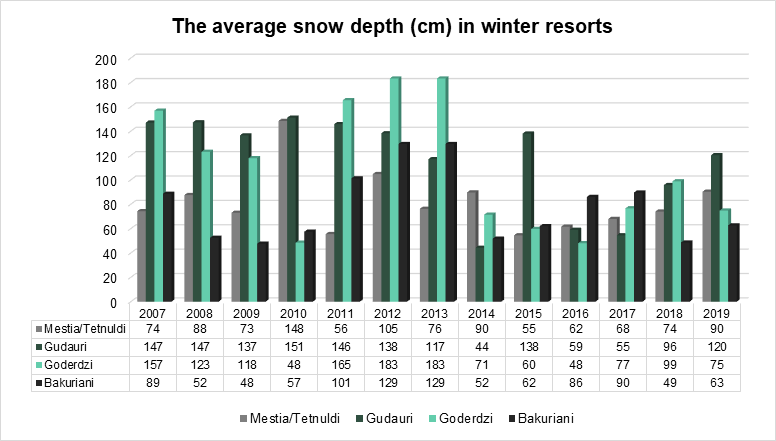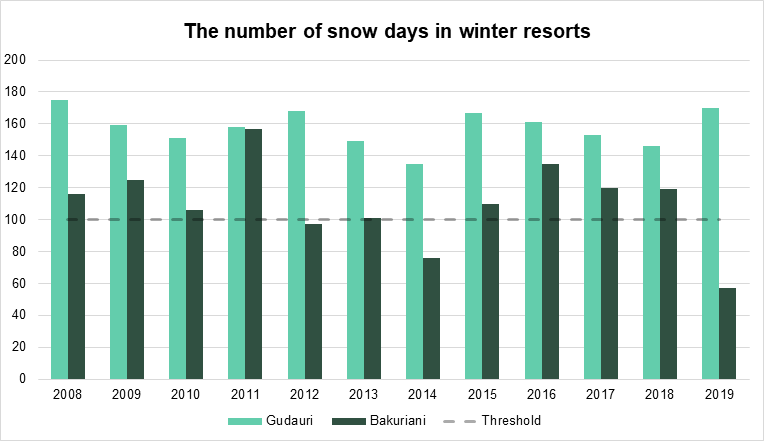 31
May
2023
31
May
2023
ISET Economist Blog
 Friday,
06
March,
2020
Friday,
06
March,
2020

 Friday,
06
March,
2020
Friday,
06
March,
2020
Georgian winter resorts have finally started their long-awaited season in February 2020, after a month and a half of poor snow. In our previous blog, we discussed the possible climate change development scenarios over the rest of the century and revealed the need for better understanding and implementation of adaptation measures. However, more still needs to be said about the expected effects of climate change on the economic viability of resorts and their possible adaptation strategies.
Figure 1 shows that, over the last 13 years, the average depth of snow in the four main winter resorts has always exceeded the critical depth limit of snow cover (30 cm), considered a minimum requirement for a well-functioning winter resort; with Bakuriani most often approaching the critical value.
Figure 1: The average snow depth (cm) in winter resorts

Another important indicator considers the number of snow days per season, i.e. the number of days when snow depth is at least 30 cm. Operators in Europe and North America usually refer to the 100-day-rule to determine the economic viability of resorts. The rule suggests that a snow depth of at least 30 cm for 100 days, per season, is required for profitability. Unfortunately, this information is only available for two resorts within the observational period, Gudauri and Bakuriani. In Gudauri, the number of snow days always exceeded 100, while Bakuriani was below the threshold four out of the last 13 years. Thus, judged by this indicator, Bakuriani is an economically vulnerable resort.
A slightly modified 100-day-rule defines if a resort is “snow reliable” by looking at the number of snow days over a 10-year period. A resort is “snow reliable” if it enjoys at least 100 days of snow in 7 out of 10 seasons. In this instance, Bakuriani is in a very vulnerable situation (on the threshold with 7 out of 10 years), whereas Gudauri is clearly classified as reliable. The data highlighting the number of snow days is reported in Figure 2.
Figure 2: The number of snow days in winter resorts

While such rule-of-thumb methods can provide a general picture of the reliability of snow in a resort, and somehow reflect economic viability, they cannot fully explain precise economic effects, particularly if a shrinking winter season does not relate to the dramatic decrease in profitability of a resort. Moreover, these methods cannot provide any information or practical guidance to policymakers.
What is more relevant, for this purpose, is the identification of the main determinants of the demand for winter resort services; an estimation of the responsiveness of resort visitors to climate changes (which affects a resort’s profits); and, in particular, the reduction in the availability of snow, given the existing (and hypothetical) characteristics of winter resorts. Estimating the responsiveness of winter tourism demand to variations in snow availability, which we economists could call the snow elasticity of demand, together with the identification of winter resort features that can help mitigate the responsiveness of demand to negative climate shocks, are important in assessing the rationale behind the adoption of climate adaptation measures and identifying economically efficient projects.
For a definition of the optimal adaptation measures, we should also consider the alternative options available for potential tourists and their likely behavioral (adaptation) responses. Therefore, it is important to ask, what exactly do we mean when discussing behavioral (adaptation) responses? Behavioral adaptation takes three major forms: spatial, temporal, and activity substitution. To clarify these forms, we can imagine how the three authors of this blog – who differ completely in their preferences towards winter tourist activities – may respond to a reduction in the number of snow days in Georgian resorts.
Norberto is Italian, and skiing for him is a simple leisure activity that he can enjoy anywhere, thus, his response towards a reduced winter season most likely would be a spatial substitution, meaning that he might decide to go to the Alps instead of Gudauri or Mestia. For Levan, skiing is more than just a leisure activity. He not only enjoys winter sports but also has a specific preference for a specific type of ski slopes. Moreover, he has a house in Gudauri. Levan consequently provides a bright example of temporal substitution, where he would still visit Gudauri, just much more frequently during the shrunken season compared to previous winters. While for Mariam, an amateur skier, it does not make any difference whether she sees snow in Bakuriani, Gudauri, or Mestia. She could even abandon skiing and opt for skating instead. Therefore, Mariam offers a quite good example of both internal spatial and activity substitution.
These examples should make it clear that investigating the expected behavioral responses of winter tourists should start with a thorough analysis of the characteristics of this heterogeneous group. Responses are likely to differ by age and nationality; older individuals often prefer activity or temporal substitution, while the young might choose a spatial or temporal substitution, and international visitors are usually prone to spatial substitution in the case of adverse climate change.
Furthermore, the conclusions of such an analysis cannot be expected to be the same for all resorts, as each resort has its own specific characteristics. For example, Gudauri commonly hosts international visitors and represents the best resort for expert skiers and snowboarders, while Georgians frequently prefer to spend their winter holidays in Bakuriani with friends or families. Thus, any effort to identify the best adaptation measures at national and local levels should keep into account all such aspects.
Possible adaptation actions might include:
• Installation of artificial snow making equipment;
• Slope grooming or landscaping via contouring or smoothing smaller areas;
• Leveling rough and bumpy surfaces and the removal of obstacles that can reduce the minimum snow depth required for skiing;
• Introducing weather derivatives, which will reduce the risks faced by averse investors of going into bankruptcy, in exchange for a premium;
• Diversification of winter activities and offering alternatives to skiing, such as tobogganing, snowshoeing, indoor sports, health tourism, etc.
For each of these actions (in certain areas some have already been adopted, as in Gudauri) it would be advisable to perform an accurate early assessment of the potential costs and benefits (economic, social, and environmental). For instance, the creation of artificial snow imposes huge energy and water accumulation costs as a result of persistently rising average winter temperatures, while slope grooming and leveling solve the problem temporarily, and these actions are only helpful with a set minimum amount of snow.1 At this stage, and in absence of more accurate analysis, the diversification of winter activities and the broadening of the options available to tourists seem the most feasible approach because of the, relatively, lower financial and infrastructural requirements. Over a longer period, however, a more comprehensive approach combining all the aforementioned adaption measures would help tackle the problem more effectively.
To summarize, climate change can be expected to increasingly challenge the viability of winter tourism. It is therefore important to approach the issue in a systematic manner, starting with a detailed analysis of the sector and the characteristics of customer preference, followed by the introduction of the most compatible and cost-effective adaptation measures. This would assuredly constitute an important step towards increasing the resilience of the sector and minimizing the potential losses associated with increased weather volatility and climate change. Nevertheless, it will remain impossible to fully safeguard the sector against both expected and unexpected threats, just as the Coronavirus crisis has recently reminded us.
1 At least 30 cm.





